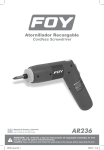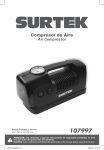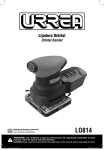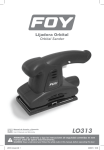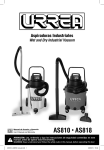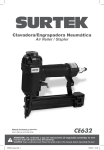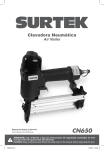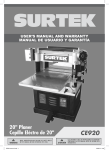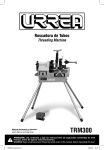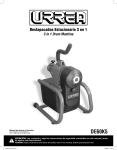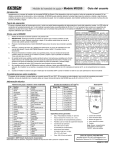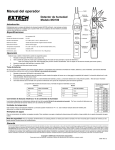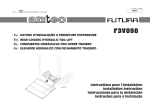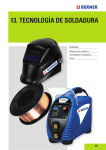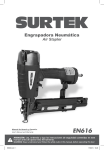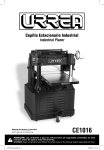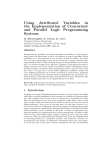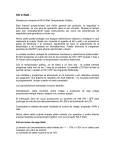Download Atornillador para Tablaroca
Transcript
Atornillador para Tablaroca Drywall Screwdriver Manual de Usuario y Garantía. User’s Manual and Warranty. AT714 ATENCIÓN: Lea, entienda y siga las instrucciones de seguridad contenidas en este manual, antes de operar esta herramienta. WARNING: Read, understand and follow the safety rules in this manual, before operating this tool. AT714 manual.indd 1 28/05/15 15:37 E S P A Ñ O L E N G L I S H CONTENIDO CONTENT Normas generales de seguridad 3 General safety rules 9 Seguridad eléctrica 3 Electric safety 9 Seguridad personal 3 Personal safety 9 Utilización y cuidados de las herramientas eléctricas 4 Tool use and care 10 Advertencias de seguridad para atornilladores para tablaroca 5 Specific safety rules for drywall screwdrivers 10 Características 5 Features 11 Instrucciones de operación 6 Operation instructions 11 Mantenimiento 7 Maintenance 13 Especificaciones técnicas 8 Technical data 13 Notas 14 Notes 14 Garantía 16 Warranty policy 16 SIMBOLOS S YM BOLS PELIGRO, ADVERTENCIA, PRECAUCIÓN: Indica un riesgo personal o la posibilidad de un daño. DANGER, CAUTION, WARNING: Indicates risk of personal injury and/or the possibility of damage. Herramientas tipo II: Doble aislamiento, protege las herramientas eléctricas. Type II power tools: Indicates double insulation. 2 AT714 manual.indd 2 28/05/15 15:37 E S P A Ñ O L • NORMAS GENERALES DE SEGURIDAD Este ATORNILLADOR PARA TABLAROCA tiene características que harán su trabajo más rápido y fácil. Seguridad, comodidad y confiabilidad fueron previstos como prioridad para el diseño del mismo, haciendo más fácil su operación. ADVERTENCIA: Lea todas las advertencias de seguridad y todas las instrucciones. La omisión de alguna de las advertencias e instrucciones que se enlistan a continuación puede dar como resultado un choque eléctrico, fuego y/o un serio daño. CONSERVE TODAS LAS ADVERTENCIAS Y TODAS LAS INSTRUCCIONES. SEGURIDAD EN EL ÁREA DE TRABAJO Mantenga el área de trabajo limpia y bien iluminada. Las áreas desordenadas y oscuras provocan accidentes. No maneje herramientas eléctricas en atmósferas explosivas, tales como en presencia de líquidos inflamables, gases o polvo. Las herramientas eléctricas crean chispas que pueden encender el polvo o los humos. Mantenga alejados a los niños y curiosos mientras maneja una herramienta eléctrica. Las distracciones pueden causarle la pérdida del control. SEGURIDAD ELÉCTRICA La clavija de la herramienta eléctrica debe coincidir con receptáculo. No modificar nunca la clavija de ninguna manera. No usar ningún adaptador de clavijas con herramientas eléctricas puestas a tierra. Clavijas no modificadas y bases coincidentes reducirán el riesgo de choque eléctrico. Evite el contacto del cuerpo con superficies puestas a tierra como tuberías, radiadores, cocinas eléctricas y refrigeradores. Hay un riesgo aumentado de choque eléctrico si su cuerpo está puesto a tierra. No exponga las herramientas eléctricas a la lluvia o a condiciones de humedad. El agua que entre en la herramienta aumentará el riesgo de choque eléctrico. No abuse del cable. No usar nunca el cable para llevar, levantar o desenchufar la herramienta Manual de U suario eléctrica. Mantenga el cable lejos del calor, aceite, cantos vivos o piezas en movimiento. Los cables dañados o enredados aumentan el riesgo de choque eléctrico. Cuando maneje una herramienta eléctrica en el exterior, use una prolongación de cable adecuada para uso en el exterior. El uso de una prolongación de cable adecuada para uso en el exterior reduce el riesgo de choque eléctrico. “ESTA HERRAMIENTA CUENTA CON UN SUJETACABLE TIPO “Y“, EN CASO DE DAÑARSE EL CORDÓN DE ALIMENTACIÓN, ÉSTE DEBERÁ SER REEMPLAZADO POR EL FABRICANTE, SUS CENTROS DE SERVICIO AUTORIZADOS, O PERSONAL CALIFICADO A FIN DE EVITAR RIESGOS.” EXTENSIONES DE CABLE NOTA: El uso de cables dañados incrementa el riesgo de descargas eléctricas o quemaduras. Si es necesario un cable de extensión, debe ser usado un cable con el tamaño adecuado de los conductores. La tabla de la siguiente página, muestra el tamaño correcto para usar dependiendo en la longitud del cable y el rango de amperaje especificado en la etiqueta de valores nominales del producto. Si está en duda, use el rango próximo más grande. Siempre use cables de extensión listados en UL, CSA ó NOM. TAMAÑOS RECOMENDADOS DE EXTENSIONES DE CABLE: Cuando esté usando el producto afuera, use una extensión para exteriores marcadas con lo siguiente: “WA” o “W”. Estas extensiones están pensadas para trabajar en exteriores y reducen el riesgo de descarga eléctrica. SEGURIDAD PERSONAL Esté alerta, vigile lo que está haciendo y use el sentido común cuando maneje una herramienta eléctrica. No use una herramienta eléctrica cuando esté cansado o bajo la influencia de 3 AT714 manual.indd 3 28/05/15 15:37 drogas, alcohol o medicamentos. Un momento de distracción mientras maneja herramientas eléctricas puede causar un daño personal serio. Use equipo de seguridad. Lleve siempre protección para los ojos. La utilización para las condiciones apropiadas de un equipo de seguridad tal como mascarilla antipolvo, zapatos no resbaladizos, gorro duro, o protección para los oídos reducirá los daños personales. Evite un arranque accidental. Asegúrese de que el interruptor está en posición apagado antes de conectar a la red y/o a la batería, coger o transportar la herramienta. Transportar herramientas eléctricas con el dedo sobre el interruptor o enchufar herramientas eléctricas que tienen en interruptor en posición encendido invita a accidentes. Retire llaves o herramienta antes de arrancar la herramienta eléctrica. Una llave o herramienta dejada unida a una pieza rotativa de una herramienta eléctrica puede causar un daño personal. No se sobrepase. Mantenga los pies bien asentados sobre el suelo y conserve el equilibrio en todo momento. Esto permite un mejor control de la herramienta eléctrica en situaciones inesperadas. Vista adecuadamente. No vista ropa suelta o joyas. Mantenga su pelo, su ropa y guantes alejados de las piezas en movimiento. La ropa suelta, las joyas o el pelo largo pueden ser cogidos en las piezas en movimiento. Si hay dispositivos para la conexión de medios de extracción y recolección de polvo, asegúrese de que éstos estén conectados y se usen correctamente. El uso de estos dispositivos puede reducir los peligros relacionados con el polvo. IMPORTANTE: Este aparato no se destina para utilizarse por personas (incluyendo niños) cuyas capacidades físicas, sensoriales o mentales sean diferentes o estén reducidas, o carezcan de experiencia o conocimiento, a menos que dichas personas reciban una supervisión o capacitación para el funcionamiento del aparato por una persona responsable de su seguridad. Los niños deben supervisarse para asegurar que ellos no empleen los aparatos como juguete. UTILIZACIÓN Y CUIDADOS DE LAS HERRAMIENTAS ELÉCTRICAS No fuerce la herramienta eléctrica. Use la herramienta eléctrica correcta para su aplicación. La herramienta eléctrica correcta hará el trabajo mejor y más seguro al ritmo para la que fue concebida. No use la herramienta eléctrica si el interruptor no gira “encendido” y “apagado”. Cualquier herramienta eléctrica que no pueda controlarse con el interruptor es peligrosa y debe repararse. Desenchufe la clavija de la fuente de alimentación y/o de la batería antes de efectuar cualquier ajuste, cambio de accesorios, o de almacenar las herramientas eléctricas. Tales medidas preventivas de seguridad reducen el riesgo de arrancar la herramienta accidentalmente. Almacene las herramientas eléctricas inactivas fuera del alcance de los niños y no permita el manejo de la herramienta eléctrica a personas no familiarizadas con las herramientas o con estas instrucciones. Las herramientas eléctricas son peligrosas en manos de usuarios no entrenados. Mantenga las herramientas eléctricas. Compruebe que las partes móviles no estén desalineadas o trabadas, que no haya piezas rotas u otras condiciones que puedan afectar la operación de las herramientas eléctricas. Las herramientas eléctricas se reparan antes de su uso, cuando están dañadas. Muchos accidentes son causados por herramientas eléctricas pobremente mantenidas. Mantenga las herramientas de corte afiladas y limpias. Las herramientas de corte mantenidas correctamente con los bordes de corte afilados son menos probables de trabarse y más fáciles de controlar. Use la herramienta eléctrica, accesorios y puntas de herramienta, etc. de acuerdo con estas instrucciones y de la manera prevista para el tipo particular de herramienta eléctrica, teniendo en cuenta las condiciones de trabajo y el trabajo a desarrollar. El uso de la herramienta eléctrica para aplicaciones diferentes de las previstas podría causar una situación de peligro. 4 AT714 manual.indd 4 28/05/15 15:37 E S P A Ñ O L • SERVICIO Haga revisar su herramienta eléctrica por un servicio de reparación calificado usando solamente piezas de reemplazo idénticas. Esto garantizará que la seguridad de la herramienta eléctrica se mantiene. ADVERTENCIAS DE SEGURIDAD PARA ATORNILLADORES DE TABLAROCA Sostenga la herramienta por las superficies aisladas cuando realice una operación donde la herramienta de perforación pueda entrar en contacto con cables ocultos o con su propio cable. El contacto con un cable “vivo” hará que las partes metálicas expuestas de la herramienta de perforación carguen eléctricamente y se descargue hacia el operador. · Conozca su herramienta eléctrica. Lea el manual del operador cuidadosamente. Aprenda sus usos y limitaciones, así como los posibles peligros específicos de esta herramienta. Siguiendo esta regla, reducirá el riesgo de descarga eléctrica, incendio o lesiones graves. · Siempre use lentes de seguridad. Los lentes de uso diario sólo serán resistentes al impacto; NO son lentes de seguridad. · Proteja sus pulmones. Use una careta o mascarilla contra el polvo si la operación va a ser polvorienta. · Proteja su audición. Use protección auditiva durante periodos prolongados de operación. · Inspeccione periódicamente los cables de la herramienta, si está dañado, llévelo a su centro de servicio autorizado más cercano. Observe constantemente la ubicación del cordón mientras trabaja. · Inspeccione que no haya piezas dañadas. Antes de seguir usando la herramienta, cualquier protección u otra pieza que esté dañada debe ser cuidadosamente evaluados para determinar si funcionará correctamente y realizará la función prevista. Verifique la alineación de las piezas móviles, la unión de las piezas móviles, ruptura de piezas, el montaje y cualquier otra condición que pueda afectar su funcionamiento. Toda protección o pieza que esté dañada debe ser reparada correctamente o reemplazada en un centro de servicio autorizado. El seguir esta regla, reducirá el riesgo de descargas eléctricas, incendios o lesiones graves. Manual de U suario · Inspeccione y saque todos los clavos de la madera antes de utilizar esta herramienta. El seguir esta regla reduce el riesgo de lesiones personales graves. · Guarde estas instrucciones. Consúltelas con frecuencia y úselas para ayudar a otros vayan a usar esta herramienta. Si le presta a alguien esta herramienta, facilítele también estas instrucciones. ADVERTENCIA: Polvo creado por el lijado, serrado, rebajado, taladrado y otras actividades de construcción contienen productos químicos que pueden producir cáncer, defectos de nacimiento u otros daños reproductivos. Algunos ejemplos de estos productos químicos son: • Plomo de las pinturas a base de plomo, • Sílice cristalina de ladrillos y cemento y otros productos de mampostería, y • Arsénico y cromo de madera tratada químicamente. El riesgo derivado a estas exposiciones varía, dependiendo de con cuánta frecuencia realice este tipo de trabajo. Para reducir su exposición a estos agentes químicos: trabaje en un área bien ventilada y trabaje con equipos de seguridad aprobados, tales como máscaras contra el polvo especialmente diseñadas para filtrar las partículas microscópicas. CARACTERÍSTICAS CONOZCA SU HERRAMIENTA Antes de intentar usar este producto, familiarícese con todas sus características de operación y requerimientos de seguridad. 4 6 2 5 3 1 5 AT714 manual.indd 5 28/05/15 15:37 1. INTERRUPTOR CON VELOCIDAD VARIABLE. El interruptor para el atornillador de tablaroca está convenientemente ubicado en el mango de la herramienta. El interruptor de velocidad variable produce mayor al girar el dial de velocidad encontrado en el gatillo. 2. BOTÓN DE TRABA. La función de bloqueo permite la operación continua y atornillado de tornillos por períodos prolongados de tiempo. 3. PALANCA DE AVANCE / REVERSA. La palanca de avance y reversa cambia la dirección de rotación de la broca. 4. PORTA PUNTAS AJUSTABLE. Su destornillador tiene un porta puntas ajustable con la cual podrá variar la profundidad del tornillo y cambiar rápidamente las puntas. 5. ADAPTADOR MAGNÉTICO. El imán mantiene sujeta la punta de atornillar y los tornillos hasta que esté listo para atornillarlos en un muro. 6. CLIP DE CORREA. Un clip para cinturón se encuentra en la parte superior de la carcasa del motor. INSTALANDO Y CAMBIANDO EL SOPORTE DE LA PUNTA Y LAS PUNTAS Para instalar o cambiar las puntas: · Instale puntas de destornillador de 1/4 pulgada insertándolas en el soporte magnético. NOTA: No es necesario retirar el soporte ajustable para instalar o retirar puntas. · Reemplace puntas de destornillador de 1/4 pulgada tirando de ellos fuera del soporte magnético. Soporte. Soporte magnético. Collarín de ajuste. Para quitar el soporte/adaptador magnético: · Tire del collarín de ajuste. El collarín de ajuste y la pieza de la punta ajustable salen de la caja de engranajes como un conjunto. · Retire el soporte magnético. Tire del soporte de puntas con pinzas si no se puede quitarla con la mano. Para volver a montar el soporte de puntas y boquilla: · Empuje el portabrocas en la abertura hexagonal del husillo hasta que el bloqueo de balín encaje en la ranura del vástago porta puntas. · Coloque la boquilla ajustable a la caja de engranes. Alinee la lengüeta levantada en el interior del soporte ajustable con la ranura de la caja de engranajes y empuje la boquilla hasta que encaje en su lugar. INSTRUCCIONES DE OPERACIÓN APLICACIONES Usted puede utilizar esta herramienta para los fines siguientes: · Atornillado de tornillos en tablaroca ENCENDIENDO Y DETENIENDO EL ATORNILLADOR: Para encender el atornillador , presione el gatillo. Suelte el gatillo para apagar el destornillador. INTERRUPTOR DE VELOCIDAD VARIABLE Ese atornillador tiene un regulador de velocidad (envía alta velocidad y torque incrementando la presión en el gatillo). La velocidad es regulada por la presión aplicada al gatillo. La cualidad de velocidad variable es particularmente util cuando se comienza el atornillado. También le permite seleccionar la mejor velocidad para distintos tipos de trabajo. Para limitar la velocidad máxima de la herramienta, rote la perilla que se encuentra en el gatillo y seleccione la velocidad deseada. BOTÓN DE TRABA El atornillador está equipado con una función de traba, el cual es conveniente para la operación continua y atornillado de tornillos por períodos prolongados de tiempo. Para bloquear en funcionamiento, presione el gatillo y oprima el botón de traba situado en el costado del mango, en seguida suelte el gatillo. Soltando el botón traba y el interruptor de encendido lo dejará operando continuamente. Para liberar la traba, presione el gatillo y suéltelo. Si usted tiene la traba de operación con- 6 AT714 manual.indd 6 28/05/15 15:37 E S P A Ñ O L • tinua activada durante el uso y el atornillador se desconecta de la fuente de alimentación, desactive la función de traba inmediatamente. PALANCA DE AVANCE / REVERSA La dirección de rotación de la broca es controlada por una palanca situada arriba del gatillo. Cuando el atornillador se mantiene en posición de funcionamiento normal, la palanca de dirección de rotación debería estar a la izquierda del interruptor para la operación de operación hacia adelante. El sentido de giro cambiará a dirección inversa cuando la palanca se encuentra a la derecha del interruptor. NOTA: El atornillador no encenderá a menos que la palanca de avance / retroceso esté ubicada totalmente hacia la izquierda o la derecha. El diseño del interruptor no permitirá cambiar la dirección de rotación, mientras que el atornillador esté funcionando. Suelte el gatillo y deje que el destornillador se detenga antes de cambiar la dirección. AJUSTANDO LA PROFUNDIDAD El porta puntas ajustable de la herramienta llevará automáticamente los tornillos a una profundidad preestablecida. Podría ser útil antes de comenzar un nuevo trabajo, hacer varias pruebas de atornillado en material de desecho para comprobar y ajustar la configuración de profundidad. Para realizar ajustes de profundidad predeterminados: · Gire el collarín de ajuste hasta obtener la profundidad deseada para el soporte de puntas o punta de atornillar. · Pruebe introducir un tornillo en material de desecho para determinar si es correcto. · Ajuste si es necesario para aumentar o disminuir a la profundidad deseada. ATORNILLANDO Hay dos opciones para sostener el mango del destornillador esto será determinado por la comodidad del operador y el ángulo de trabajo. El atornillador tiene un interruptor de velocidad variable para un buen manejo del operador y así pueda controlar la velocidad y torque. · Asegúrese de que el atornillador esté apagado antes de conectarlo a la fuente de alimentación. Manual de U suario · Compruebe que el sentido de giro de la palanca sea el correcto (adelante o atrás). · Asegure la pieza de trabajo. Use abrazaderas si es necesario. · Enchufe el atornillador a la fuente de alimentación. · Oprima el gatillo para encender el atornillador. No trabe el interruptor de encendido en trabajos donde pueda necesitar que el atornillador se detenga de repente. · Sostenga el atornillador con firmeza y coloque la broca y el tornillo en el punto donde ser introducido. NOTA: El portapuntas está magnetizado y sostendrá la mayoría de tornillos para tablaroca comerciales. · Aplique una presión rápida y de golpe para introducir la broca. La presión aplicada activará el embrague y apretará el tornillo. MANTENIMIENTO ADVERTENCIA: Cuando repare la herramienta use solamente repuestos idénticos Surtek. El uso de cualquier otro repuesto puede crear un riesgo o dañar el producto . ADVERTENCIA: Siempre use lentes de seguridad o lentes protectores con protección lateral al usar herramientas eléctricas o al soplar el polvo. Si la operación genera mucho polvo, también utilice una mascarilla contra polvo. MANTENIMIENTO GENERAL Evite el empleo de solventes al limpiar las piezas de plástico. La mayoría de los plásticos son susceptibles a daños causados por diferentes tipos de solventes comerciales y pueden dañarse con el uso. Use paños limpios para eliminar la suciedad, polvo, aceite, grasa, etc. ADVERTENCIA: No permita que en ningún momento, fluidos para frenos, gasolina, productos a base de petróleo, aceites penetrantes, etc., entren en contacto con las piezas de plástico. Las sustancias químicas pueden dañar, debilitar o destruir el plástico, lo cual puede resultar en lesiones personales graves. Las herramientas eléctricas que se utilizan en materiales de fibra de vidrio, madera laminada y yeso están sujetas a desgaste acelerado y posible fallo prematuro porque las partículas 7 AT714 manual.indd 7 28/05/15 15:37 de fibra de vidrio y de desbaste son altamente abrasivas para los baleros, carbones, conmutadores, etc. Nosotros no recomendamos el uso de esta herramienta para trabajos extendidos en estos tipos de materiales. Sin embargo, si usted trabaja con cualquiera de estos materiales, es sumamente importante limpiar la herramienta usando aire comprimido. ESPECIFICACIONES TÉCNICAS VOLTAJE-FRECUENCIA 120 V ~ 60 Hz VELOCIDAD (0 - 4 000) r/min CAPACIDAD DE PORTAPUNTAS 1/4" (6,3 mm) POTENCIA 710 W CONSUMO ENERGÉTICO 0,3 kWh PESO 1,3 kg (2,8 lb) LUBRICACIÓN Todos los baleros de esta la herramienta están lubricados con suficiente cantidad de lubricante de alta calidad para la vida de la unidad en condiciones normales de funcionamiento. Por lo tanto, no se requerirá lubricación adicional. 8 AT714 manual.indd 8 28/05/15 15:37 E N G L I S H • GENERAL SAFETY RULES Your DRYWALL SCREWDRIVER has many features that will make your job faster and easier. Safety, performance and reliability have been given top priority in the design of this tool, qualities to make easy to maintain and to operate. WARNING: Read and understand all instructions. Failure to follow all indications listed below, may result in electric shock, fire and/ or serious personal injury. SAVE THESE INSTRUCTIONS. SAFETY IN WORKING AREA Keep your work area clean and well lit. Cluttered benches and dark areas may cause accidents. Do not operate power tools in explosive atmospheres, such as in the presence of flammable liquids, gases or dust. Some power tools create sparks which may provoke fire. Keep away observers, children and visitors while operating a power tool. Distractions can cause you to lose control. ELECTRIC SAFETY Double insulation eliminates the need for the three wire grounded power cord and grounded power supply system. Avoid the body contact with grounded surfaces such as pipes, radiators and refrigerators. There is an increased risk of electric shock if your body is grounded. Don’t expose power tools to rain or wet conditions. The precense of water into power tools will increase the risk of electric shock. Do not abuse of the power cord. Never use the power cord to carry the tool and do not pull the plug off the outlet. Keep the cable away of heat, oil, sharp edges or moving parts. Replace damaged cords immediately. Damaged cords increase the risk of electric shock. When operating a power tool outside, use an outdoor extension cord marked “W-A” or “W”. These cords are rated for outdoor use and reduce the risk of electric shock. EXTENSION CORDS Replace damaged cords immediately. The use of damaged cords can shock, burn or electric U ser's manual shock. If an extension cord is necessary, a cord with adequate size conductors should be used to prevent excessive voltage drop, loss of power or overheating. The table below shows the correct size to use, depending on cord length and nameplate amperage rating of tools. In case of doubt use the next heavier gauge. Always use UL listed extension cords. SIZE RECOMMEND EXTENSION CABLES PERSONAL SAFETY Stay alert, watch what you are doing and use common sense when operating a power tool. Don’t use the tool if you are tired or under the influence of drugs, alcohol or medication. A moment of unattention while operating power tools may cause a serious personal injury. Dress properly. Do not wear loose clothing or jewellery. Contain long hair. Keep your hair, clothing and gloves away of moving parts. Loose clothes, jewellery or long hair can be caught in moving parts. Avoid an accidental starting. Be sure that the switch is OFF before plugging in. Carrying tools with the finger on the switch or plug in the tool switch in ON may cause accidents. Remove the adjusting keys or wrenches before turning the tool on. A wrench or a key that is left close to a rotating part of the tool may provoke a personal injury. Do not overreach. Keep proper footing and balance at all times. Proper footing and balance enables better control of the tools on unexpected situations. Use safety equipment. Always wear eye protection. Dust mask, nonskid safety shoes, hard hat, or hearing protection must be used for appropriate conditions. Before connecting the tool to a power source (receptacle, outlet, etc.) be sure that the voltage supplied is the same as that one specified on the nameplate of the tool. To use a not specified voltage may cause a serious injury to the user as well as damage the tool. 9 AT714 manual.indd 9 28/05/15 15:37 IMPORTANT: This appliance is not intended for use by persons (including children) with reduced physical, sensory or mental capabilities may be different or reduced, or lack of experience or knowledge, unless such persons are supervised or trained to operate the product by a person responsible for their safety. Children should be supervised to ensure they do not use the devices as toys. TOOL USE AND CARE Do not force the power tool. Use the correct tool for the application. The correct tool will do the job better and more safely at the rate that it was designed to work at. Do not use tools if switch does not turn it on or off. Any tool that cannot be controlled whith the switch is dangerous and must be repaired. Disconnect the plug from the power source before making any adjustments, changing accessories or storing the tool. This preventive safety measures reduce the risk of accidental starting of the tool. When the power tool is not in use, store it out of the reach of children, and do not allow individuals who are not familiar with the power tool or these instructions to operate it. Power tools are dangerous in the hands on untrained users. Maintain the power tool. Check for misalignment or binding of moving parts, broken parts, and any other condition that may affect the operation of the power tool. If it is damaged, have it repaired before using. Many accidents are caused by poorly maintained power tools. Check for misalignment or bonding of moving parts, breakage parts, and any other condition that may affect the tools operation. If you find a damaged tool, take it to service before use it. Use only accessories that are recommended by the manufacturer of your model. Suitable accessories for one tool, may become hazardous when are used on another tool. Keep cutting tools, sharpened and clean. Cutting tools in good condition with sharpened edges, are less likely to stuck in workpieces or easier to control. Is recommendable to use a safety device suitable, such a thermal and diferential switch when you are using an electric equipment. SERVICE Tool service must be perfomed only by qualified repair personnel. Service or maintenance performed by unqualified personnel could result in a risk of injury. SPECIFIC SAFETY RULES FOR DRYWALL SCREWDRIVERS Hold tool by insulated gripping surfaces when performing an operation where the drilling tool may contact hidden wiring or its own cord. Contact with a“live” wire will make exposed metal parts of the drilling tool become electric and shock the operator. ·Know your power tool. Read operator’s manual carefully. Learn its applications and limitations, as well as the specific potential hazards related to this tool. Following this rule will reduce the risk of electric shock, fire, or serious injury. · Always wear safety glasses. Everyday eyeglasses have only impact-resistant lenses; they are NOT safety glasses. Following this rule will reduce the risk of serious personal injury. · Protect your lungs. Wear a face or dust mask if the operation is dusty. Following this rule will reduce the risk of serious personal injury. · Protect your hearing. Wear hearing protection during extended periods of operation. Following this rule will reduce the risk of serious personal injury. · Inspect tool cords periodically and, if damaged, have repaired at your nearest authorized service center. Constantly stay aware of cord location. Following this rule will reduce the risk of electric shock or fire. · Check damaged parts. Before further use of the tool, a guard or other part that is damaged should be carefully checked to determine that it will opérate properly and perform its intended function. Check for alignment of moving parts, binding of moving parts, breakage of parts, mounting, and any other conditions that may affect its operation. A guard or other part that is damaged should be properly repaired or replaced by an authorized service center. Following this rule will reduce the risk of shock, fire, or serious injury. · Inspect for and remove all nails from lumber before using this tool. Following this rule will reduce the risk of serious personal injury. 10 AT714 manual.indd 10 28/05/15 15:37 E N G L I S H • · Save these instructions. Refer to them frequently and use them to instruct others who may use this tool. If you loan someone this tool, loan them these instructions also. WARNING: Some dust created by power sanding, sawing, grinding, drilling, and other construction activities contains chemicals known to cause cancer, birth defects or other reproductive harm. Some examples of these chemicals are: • lead from lead-based paints, • crystalline silica from bricks and cement and other masonry products, and • arsenic and chromium from chemically-treated lumber. Your risk from these exposures varies, depending on how often you do this type of work. To reduce your exposure to these chemicals: work in a well ventilated area, and work with approved safety equipment, such as those dust masks that are specially designed to filter out microscopic particles. U ser's manual 3. FORWARD/REVERSE LEVER. The forward/ reverse lever changes the direction of bit rotation. 4. ADJUSTABLE NOSEPIECE. Your screwdriver has an adjustable nosepiece for varying screw depth and easy bit changes. 5. MAGNETIC BIT HOLDER. The magnet holds the screwdriver bit and screws until you are ready to drive them into drywall. 6. BELT CLIP. A convenient belt clip is located on top of the motor housing. INSTALLING AND REPLACING BIT HOLDER AND BITS To install or replace bits: · Install 1/4 in. screwdriver bits by inserting them into the magnetic bit holder. NOTE: It is not necessary to remove the adjustable nosepiece to install or remove bits. · Replace 1/4 in. screwdriver bits by pulling them out of the magnetic bit holder. Tool support. Magnetic support. FEATURES KNOW YOUR TOOL Before attempting to use this hammer drill, become familiar with all of its operating features and safety requirements. 4 6 2 5 3 1 1. SWITCH TRIGGER WITH VARIABLE SPEED DIAL. The switch trigger for your drywall screwdriver is conveniently located on the handle of the tool. The variable speed switch delivers higher speed with increased trigger pressure and selecting with the dial. 2. LOCK-ON BUTTON. The lock-on feature allows for continuous driving of screws for extended periods of time. Adjustment sleeve. To remove the magnetic bit holder: · Pull the adjusting sleeve. The adjusting sleeve and adjustable nosepiece come off the gear casing as a set. · Remove the magnetic bit holder. Pull the bit holder out with pliers if you cannot remove it by hand. To reassemble the bit holder and nosepiece: · Push the bit holder into the hex opening of the spindle until the ball lock snaps into the groove in the bit holder shank. · Attach the adjustable nosepiece to the gear case. Align the raised tab inside the adjustable nosepiece with the groove on the gear case and push the nosepiece until it snaps into place. OPERATION INSTRUCTIONS APPLICATIONS You may use this tool for the purposes listed below: · Driving screws in drywall. 11 AT714 manual.indd 11 28/05/15 15:37 STARTING/STOPPING THE SCREWDRIVER To turn the screwdriver ON, depress the switch trigger. Release the switch trigger to turn the screwdriver OFF. VARIABLE SPEED SWITCH Your hammer drill has a variable speed dial on switch. The speed is regulated by the pressure applied to the switch. Variable speed is particularly useful when starting the hammer drill. Also allows you to set an optimal speed for any kind of job. LOCK-ON BUTTON The screwdriver is equipped with a lock-on feature which is convenient for continuous driving of screws for extended periods of time. To lock-on, depress the switch trigger, push in and hold the lock-on button located on the side of the handle, then release switch trigger. Release the lock-on button and the screwdriver will continue running. To release the lock, depress the switch trigger and release. If you have the lock-on feature engaged during use and the screwdriver becomes disconnected from the power supply, disengage the lock-on feature immediately. FORWARD/REVERSE LEVER The direction of rotation of the bit is controlled by a lever located above the switch trigger. With the screwdriver held in normal operating position, the direction of rotation lever should be positioned to the left of the switch for forward driving operation. The direction of rotation is in reverse when the lever is to the right of the switch. NOTE: The screwdriver will not run unless forward/reverse lever is pushed fully to the left or right. The design of the switch will not permit changing the direction of rotation while the screwdriver is running. Release the switch trigger and allow the screwdriver to stop before changing its direction. SETTING DEPTH The adjustable nosepiece of your tool will automatically drive screws to preset depths. It may be helpful to begin each new job by driving several test screws in scrap material to check and adjust the depth setting. To make preset depth adjustments: · Rotate the adjusting sleeve until you obtain the desired depth for the bit holder or screwdriver bit. · Test drive a screw in scrap material to determine if it is correct. · Adjust as necessary to increase or decrease the desired depth. DRIVING SCREWS There are two two options for gripping the handle of the screwdriver, determined by operator comfort and working angle. The screwdriver has a variable speed switch for operator control of speed and torque limits. · Be sure the screwdriver is in the OFF position before connecting it to the power supply. · Check the direction of rotation lever for correct setting (forward or reverse). · Secure the workpiece. Use clamps if necessary. · Plug the screwdriver into power supply source. · Depress the switch trigger to start the screwdriver. Do not lock the switch ON for jobs where the screwdriver may need to be stopped suddenly. · Hold the screwdriver firmly and place the bit and screw at the point to be driven. NOTE: The bit holder is magnetized and will hold most commercial drywall screws. · Apply quick, snap action type pressure to the bit. The pressure applied will engage the clutch and drive the screw. MAINTENANCE WARNING: When servicing use only identical SURTEK replacement parts. Use of any other parts may create a hazard or cause product damage. WARNING: Always wear safety goggles or safety glasses with side shields during power tool operation or when blowing dust. If operation is dusty, also wear a dust mask. 12 AT714 manual.indd 12 28/05/15 15:37 E N G L I S H • GENERAL MAINTENANCE Avoid using solvents when cleaning plastic parts. Most plastics are susceptible to damage from various types of commercial solvents and may be damaged by their use. Use clean cloths to remove dirt, dust, oil, grease, etc. WARNING: Do not at any time let brake fluids, gasoline, petroleum-based products, penetrating oils, etc., come in contact with plastic parts. Chemicals can damage, weaken or destroy plastic which may result in serious personal injury. Electric tools used on fiberglass material, wallboard, spackling compounds, or plaster are subject to accelerated wear and possible premature failure because the fiberglass chips and grindings are highly abrasive to bearings, brushes, commutators, etc. Consequently, we do not recommended using this tool for extended work on these types of materials. However, if you do work with any of these materials, it is extremely important to clean the tool using compressed air. U ser's manual TECHNICAL DATA VOLTAGE-FREQUENCY 120 V ~ 60 Hz SPEED (0 - 4 000) r/min BIT HOLDER CAPACITY 1/4” (6,3 mm) POWER 710 W POWER CONSUMPTION 0,3 kWh WEIGHT 1,3 kg (2,8 lb) LUBRICATION All of the bearings in this tool are lubricated with a sufficient amount of high grade lubricant for the life of the unit under normal operating conditions. Therefore, no further lubrication is required. 13 AT714 manual.indd 13 28/05/15 15:37 Notas / Notes 14 AT714 manual.indd 14 28/05/15 15:37 M a n u a l d e u s u a r i o / U s e r ’s m a n u a l Notas / Notes 15 AT714 manual.indd 15 28/05/15 15:37 E S P A Ñ O L E N G L I S H POLIZA DE GARANTÍA WARRANT POLICY Urrea Herramientas Profesionales S.A. de C.V. garantiza este producto por el termino de 2 años en sus piezas, componentes y mano de obra contra cualquier defecto de fabricación a partir de la fecha de entrega. Urrea Herramientas Profesionales S.A. de C.V. Warranties this product for a period of 2 years in its parts, components and manual labour against any manufacture defect from the purchasing date. Fecha de venta: ____/____/____ Producto: ___________________ Marca: ______________________ Modelo: ____________________ Purchase date: ____/____/____ Product:____________________ Brand:______________________ Model:______________________ ______________________________ Sello y firma de distribuidor ______________________________ Distributor seal and signature Comercializado e Importado por: Urrea Herramientas Profesionales S.A. de C.V. km 11,5 Carretera A El Castillo, El Salto, Jalisco, México. C. P. 45680, Tel. (33) 3208 7900, RFC UHP900402Q29 Sold and Imported by: Urrea Herramientas Profesionales S.A. de C.V. km 11,5 Carretera A El Castillo, El Salto, Jalisco, México. C. P. 45680, Tel. (33) 3208 7900, RFC UHP900402Q29 Condiciones: Para hacer efectiva la garantía deberá presentar el producto junto con la poliza de garantia debidamente firmada y sellada por el establecimiento donde la adquirio, en cualquiera de los centros de servicio autorizados. Los gastos de transportación que se deriven del cumplimiento de la garantía seran cubiertos por: Urrea Herramientas Profesionales S.A. de C.V. Terms: In order to make warranty effective you must present the product along with the warranty properly fillled and signed to an authorized distributor or service center. Esta garantía no será valida en los siguientes casos: · Cuando el producto haya sido utilizado en condiciones distintas a las normales o al desgaste natural de sus partes. · Cuando el producto no haya sido operado de acuerdo al instructivo de uso que lo acompaña. · Cuando el producto haya sido alterado o reparado por personas no autorizadas. This warranty is not applicable in the following cases: · When the product has not been used according to normal conditions or natural wear of its parts. · When the product has not been used according with this user’s manual instructions. · When the product has been fixed or modified by unauthorized or unqualified person. AT714 Urrea Herramientas Profesionales S.A. de C.V. will cover the transportation cost related to the warranty. 16 AT714 manual.indd 16 28/05/15 15:37
















